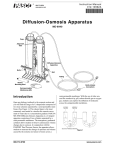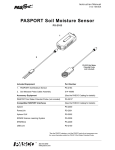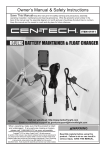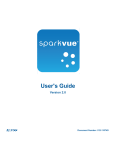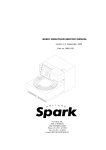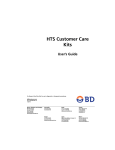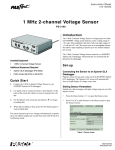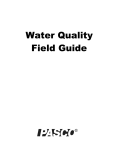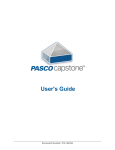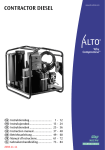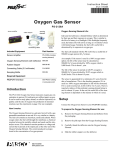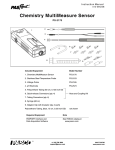Download PASCO Specialty & Mfg. PS-2207 User's Manual
Transcript
Instruction Sheet 012-10927D Blood Pressure Sensor with Cuff PS-2207,PS-2208,PS-2209 Eight pin mini-DIN connector Blood Pressure Sensor Quick-connect port Quick-connector Push-button Release Valve Hook-and-pile Material Bulb Blood Pressure Cuff with Bulb and Valve The illustrations are not to scale. \ Included Equipment Part Number Blood Pressure Sensor with 3 available cuff sizes PS-2207,PS-2208,PS-2209 Blood Pressure Cuff with Bulb & Valve (3 sizes available)** PS-2531,PS-2532,PS-2533** Recommended Items PASPORT Extension Cable PS-2500 PASCO Interface Catalog or web site* Data Acquisition Software Catalog or web site* *See the PASCO catalog or web site at www.pasco.com for compatible PASPORT interfaces and Data Acquisition Software. **NOTE: The 3 Blood Pressure Cuff sizes are: PS-2531 (small), PS-2532 (standard/adult) and PS-2533 (large). PS-2207 includes the standard/adult cuff, PS-2208 contains the small cuff and PS-2209 contains the large cuff. See the PASCO catalog or web site. 800-772-8700 www.pasco.com +1 916 786 3800 [email protected] Model No.PS-2207,PS-2208,PS-2209 Introduction Introduction With the PASPORT Blood Pressure Sensor, students can easily measure heart rate (beats per minute) and systolic and diastolic arterial blood pressure (millimeters of mercury). Students gain a greater understanding of the physiology of the circulatory system when they also learn about the physiology of blood pressure. The systolic and diastolic pressure provided in the digit display can be used by the student to verify their own determination of blood pressure from a graph of pressure versus time. Left arm Blood pressure is the force that blood exerts on the walls of blood vessels. This pressure is caused by the contraction of the heart and by muscles that surround blood vessels. Blood pressure is always highest in the two main arteries that leave the heart. Because the pressure is usually a little higher in the left artery, blood pressure is usually measured in the brachial artery supplying the left arm. Blood pressure consists of two measurements: systolic and diastolic pressure. It is represented as a ratio of systolic pressure to diastolic pressure, for example 130/80 (“one-thirty over eighty”). Brachial artery In most parts of the world, blood pressure is reported in millimeters of mercury (mmHg). Systolic pressure is the pressure of the blood on the artery walls when it leaves the ventricles at peak ventricular contraction, when the heart is emptying its chambers of blood. It is the "top number" of the blood pressure ratio. Normal systolic pressure for a male is approximately 120 mmHg and for females is approximately 110 mmHg. Palm Diastolic pressure is the pressure of the blood on the artery walls when the ventricles relax and the heart's chambers fill with blood. It is the "bottom number" of the blood Figure 1: Brachial artery pressure ratio. Normal diastolic pressure for a male is approximately 80 mmHg and for females is approximately 70 mmHg. Systolic and diastolic pressures are affected by various biological and environmental factors. For example, the salt in a person's diet can cause the kidneys to change the amount of fluid in our blood, resulting in changes in blood pressure. Diet, stress, exercise, body position, drugs, hormonal changes and genetic factors can affect a person's blood pressure. About the Sensor The PASPORT Blood Pressure Sensor consists of a pressure sensor box and a blood pressure cuff with bulb and valve. The sensor is a digital sphygmomanometer that measures mean arterial pressure and then calculates systolic and diastolic blood pressure and heart rate (in beats per minute). NOTE: The PASPORT Blood Pressure Sensor includes a standard size blood pressure cuff with bulb and valve (PS-2532). The blood pressure cuff consists of an inflatable bladder connected by one hose to a hand pump bulb with a push-button release valve, and by a second hose to the pressure sensor box. A smaller size blood pressure cuff (PS-2531), a larger size blood pressure cuff (PS-2533), and a standard size replacement cuff (PS-2532) are available separately. The Blood Pressure Sensor can be connected to any PASPORT interface (such as the SPARK Science Learning System (SLS) or SPARKlink). The sensor can be used with the PASPORT Extension Cable. This cable is 2 meters in length, extending the distance a sensor can reach from a computer or portable datalogger. ® See the PASCO catalog or web site for more information. PS-2500 PASPORT Extension Cable www.pasco.com 2 Model No.PS-2207,PS-2208,PS-2209 Introduction Indicator Light Emitting Diodes The sensor has two light emitting diodes (LEDs) mounted inside the pressure sensor case. When they are active, the LEDs can be seen through the case. One is orange and the other is green. The orange LED begins to flash as the cuff is being inflated (starting when the pressure reaches 50 mmHg). Once the cuff is inflated, the orange LED shines continuously while the sensor is making pressure readings. The orange LED goes out when the air in the cuff is released and the pressure drops to about 35 mmHg. The green LED flashes to indicate a heart beat. Usage Experiment ideas: • Determine the effects of exercise on blood pressure and heart rate. • Explore the effects of body position on blood pressure and heart rate. • Compare the blood pressure and heart rate of students in the class. Procedure Sensor Sensor Setup 1. First, find a partner. A student cannot measure his or her own blood pressure. Partner 1 should be the patient and partner 2 should conduct the measurement. 2. Connect the blood pressure cuff to the Blood Pressure Sensor. Align the quick connector at the end of the tube from the cuff with the quick connector port on the sensor. Push the quick connector onto the port and turn the connector clockwise until the connector clicks into place on the port. 3. Connect the Blood Pressure Sensor to a PASPORT interface. 4. If you will be using a computer, connect the PASPORT interface to the computer’s USB port. 5. Create Digits displays of pressure, diastolic pressure, and systolic pressure. Your may also want to view pressure versus time data in a Graph display. Cuff and Arm Placement 1. The patient should remove any constrictive clothing or jewelry that may interfere with the cuff placement. 2. Locate the approximate position of the main artery (brachial artery) on the inside of your upper left arm by pressing with your fingers near the inside edge of your biceps muscle about five or ten centimeters (cm) above the elbow pit. Quickconnector Figure 23: Quick-connector onto sensor NOTE: Refer to your PASPORT interface users guide for information about setting up data displays and recording data.. Upper Left Arm Cuff Tubes 3. Partner 2 should help the patient wrap the cuff snugly around the upper left arm above the elbow with the two tubes hanging down (one on each side of the arm). 4. Use the hook-and-pile material to hold the cuff in place. Position the cuff's bottom edge at about 2.5 cm (one inch) above the elbow pit. Elbow pit Figure 3: Cuff onto upper left arm ® 3 Blood Pressure Sensor 5. Rotate the cuff as needed to position the white index line (labeled ARTERY) on the cuff over the main artery (brachial artery) on the inside of your left arm. 6. Sit without crossing your legs. Relax. Rest your left elbow and forearm on a solid surface with your palm facing upward. The cuff should be slightly lower than your heart. 7. Partner 2 should press and hold the push-button release valve to make sure that all of the air in the cuff has been released. Sample Data Collect Data 1. The patient should stay as still as possible during the blood pressure measurement. Do not talk or move if possible. 2. Partner 2 should press “Start” to begin data collection and then he or she should use the bulb to pump air into the cuff. 3. Monitor the pressure in the Digits display. 4. When the pressure reaches approximately 170 mmHg, partner 2 should stop pumping and let go of the bulb. NOTE: The pressure in the cuff will decrease automatically (at about 3 mmHg per second) so the cuff will slowly deflate by itself in about a minute or so. 5. CAUTION: Do not pump above 200 mmHg. If there is serious discomfort, deflate the cuff and remove it. See “Troubleshooting” on page 6 for information about adjusting the pressure release rate. When the cuff is deflated, press “Stop” to end data collection. After the measurement is finished, release the remaining air in the cuff by pressing the push-button release valve on the bulb and holding it for several seconds. You should be able to hear air coming out of the cuff. Sample Data 4 ® Model No.PS-2207,PS-2208,PS-2209 Sample Data How To Find Systolic and Diastolic Blood Pressure Manually 1. Select a single data run. Enlarge an area of the pressure measurement between 120 and 60 mmHg. 2. Identify when your data begins to form ‘blips’ (small bumps). This is your systolic pressure. 3. Next, identify when your data stops forming ‘blips’ (small bumps). This is your diastolic pressure. 4. You may need to change your sample rate in order to see the ‘blips’. Identify when your data begins to have ‘blips’ (small bumps). This is your systolic pressure. Identify when your data stops forming ‘blips’ (small bumps). This is your diastolic pressure. You may need to change your sample rate to see the ‘blips’. ® 5 Blood Pressure Sensor Trou bleshoot i ng Troubleshooting Why are the Systolic and/or Diastolic Pressure Not Appearing? • Perhaps the size of the cuff is incorrect. You may have a cuff that is too small or too large. • The pressure in the cuff may be falling too quickly, or not fast enough. The pressure release rate should be between 2 and 5 mmHg per second, and never less than 2 mmHg per second. Adjusting the Pressure Release Rate for the Blood Pressure Cuff The default pressure release rate is 3 mmHg per second. To adjust the rate up or down, use a small screwdriver to turn the adjustment screw in the center of the top of the push-button valve. Turn the screwdriver counter-clockwise to slow down the release rate and turn the screwdriver clockwise to speed up the release rate. The pressure release rate is normally slower if the person’s arm is larger. Adjust the screw on the push-button valve Storage Disconnect the blood pressure cuff from the sensor for storage. Average Blood Pressure Values Measurement Important Range Normal 120/80 or less Pre-hypertension 120/80 to 140/90 High greater than 140/90 Very high greater than 180/110 The PASCO Blood Pressure Sensor is designed for educational use only. It cannot be used for diagnosis. Specifications Heart Rate Blood Pressure Gage Pressure Units beats per minute (bpm) millimeters of mercury (mmHg) mmHg, N/m2, kPa, atm, psi Range 36 to 200 bpm 0 to 375 mmHg 0 to 375 mmHg Accuracy 1 bpm see gage pressure 3 mmHg Resolution 1 bpm see gage pressure 0.05 mmHg Mean Arterial Pressure (MAP) Ideal MAP is defined as 93 mmHg, which corresponds to 120/80. SP = Systolic Pressure DP = Diastolic Pressure Three formulas are used to compute MAP. All three produce similar results, Method #1: MAP = DP + (1/3 (SP - DP)) Method #2: MAP = (2/3 DP) + (1/3 SP) Method #3: MAP = ((2*DP) + SP)/3 6 ® Model No.PS-2207,PS-2208,PS-2209 Technical Support Technical Support For assistance with any PASCO product, contact PASCO at: Address: PASCO scientific 10101 Foothills Blvd. Roseville, CA 95747-7100 Web: www.pasco.com Phone: Email: [email protected] +1 916 786 3800 (worldwide) 800-772-8700 (U.S.) For more information about the Blood Pressure Sensor and the latest revision of this Instruction Sheet, visit the PASCO web site at www.pasco.com and enter PS-2207 in the Search window. Limited Warranty For a description of the product warranty, see the PASCO catalog. Copyright The PASCO scientific 012-10927D Blood Pressure Sensor Instruction Sheet is copyrighted with all rights reserved. Permission is granted to non-profit educational institutions for reproduction of any part of this manual, providing the reproductions are used only in their laboratories and classrooms, and are not sold for profit. Reproduction under any other circumstances, without the written consent of PASCO scientific, is prohibited. Trademarks PASCO, PASCO scientific, DataStudio, PASPORT, Xplorer, and Xplorer GLX are trademarks or registered trademarks of PASCO scientific, in the United States and/or in other countries. For more information visit www.pasco.com/legal. Windows is a registered trademark of Microsoft Corporation in the United States and/or other countries. Mac is trademark of Apple Computer, Inc., registered in the U.S. and other countries. Product End of Life Disposal Instructions: This electronic product is subject to disposal and recycling regulations that vary by country and region. It is your responsibility to recycle your electronic equipment per your local environmental laws and regulations to ensure that it will be recycled in a manner that protects human health and the environment. To find out where you can drop off your waste equipment for recycling, please contact your local waste recycle/disposal service, or the place where you purchased the product. The European Union WEEE (Waste Electronic and Electrical Equipment) symbol (to the right) and on the product or its packaging indicates that this product must not be disposed of in a standard waste container. ® 7







